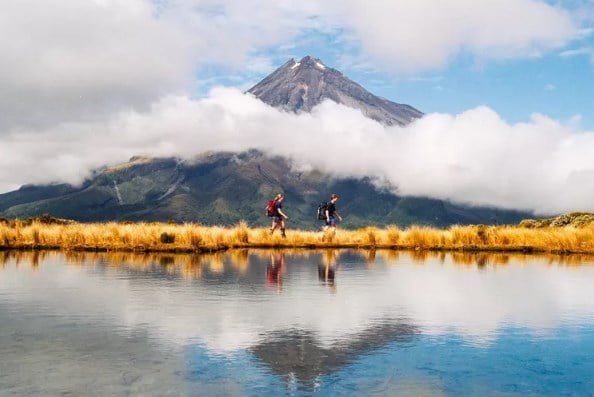New Zealand’s Department of Conservation (DoC) runs a network of campsites and basic huts throughout the country, both within national parks and near other areas of natural beauty and interest. Some are very basic while others are very well equipped. These should be your first port of call when backpacking in New Zealand, although some privately run campsites and lodges in remote areas can also be found.
Best Time to Go
Generally speaking, New Zealand experiences a warm-to-hot summer (December, January, and February) and cool, wet winter (June, July, and August). Spring and autumn are somewhere in between. There’s also a lot of variation between the North and South Islands, inland and coastal regions, mountains and sea-level locations, and west and east coasts. The weather is also notoriously changeable as New Zealand is an island nation.

The best time to visit New Zealand for backpacking, hiking, and camping outdoors will somewhat depend on your own preferences. However, most people would agree that between October and April is the best time to go backpacking in New Zealand. Hiking trails and campsites tend to be busier with locals and international tourists mid-summer (late December to late January). The weather is usually warmest and driest at this time, but if you’re hiking at lower altitudes (such as in the Abel Tasman National Park or Northland), the daytime temperature might actually be too warm. The shoulder seasons (spring and autumn) are often preferred for the quieter trails and more comfortable temperatures.
Mid-winter backpacking in New Zealand is generally not advisable, especially in the mountains, unless you have advanced winter backcountry skills. Expect snow in the mountains, and many campsites and DoC huts will be closed for the season.
Whenever you decide to go backpacking in New Zealand, be prepared for heat, snow, rain, and wind.
Best Backpacking Destinations
Wherever you go in New Zealand, you won’t be far from great hiking trails and campsites. The South Island is more sparsely populated than the North Island, with only about a quarter of New Zealand’s overall population and seven out of the country’s national parks. It also has larger and more mountains. These make the South Island a favorite destination for outdoor lovers, although there’s still a lot to enjoy on the North Island.
Three of the DoC-run Great Walks are on the North Island, six on the South, and one on Rakiura Stewart Island. Accommodation on the most popular of these books up very quickly, though, usually within hours of bookings opening in June for the following summer season. If you can’t get a spot on one of these highly coveted walks, aim for other national or provincial park trails. Here are some of the best areas to go backpacking on both islands:
Coromandel Peninsula, North Island. The whole interior of this peninsula east of Auckland is covered in forested mountains. The Pinnacles Walk, or Kauaeranga Kauri Trail, in the Coromandel Forest Park is a popular walk that can be done in one long day or two shorter ones. There are basic huts in the mountains and more comfortable campgrounds in the small towns of the Coromandel, such as Thames, Coromandel Town, and Whitianga.
Te Urewera, North Island. The Te Urewera region of the eastern North Island used to be a national park until administration was handed back to the indigenous Tuhoe people in 2014. The Lake Waikaremoana Great Walk is a major draw of the remote region, loved for its rugged trails and stunning cliff-top views across Lake Waikaremoana.
Marlborough Sounds, South Island. The drowned river valleys of the Marlborough Sounds, on the eastern side of the top of the South Island, aren’t a national park because much of the area is privately owned and farmed. However, it’s sparsely populated and contains some great hiking trails, including the Queen Charlotte Track and the Nydia Track.
Nelson Lakes National Park, South Island. Because this park doesn’t contain a Great Walk, it tends to be somewhat quieter than other South Island national parks. There are 16 lakes within the park, most of which can only be reached on foot. The mountains here mark the northern start of the Southern Alps range.
Mackenzie Country, South Island. If camping under a sky full of stars sounds like the stuff of dreams, don’t miss the Mackenzie Country in western Canterbury. It’s classified as an International Dark Sky Reserve, one of eight globally and the only one in the Southern Hemisphere. Mount Cook, the highest mountain in New Zealand, is to the west.
West Coast, South Island. When New Zealanders talk of the West Coast, they mean the west coast of the South Island. This wet, wild region stretches from the Kahurangi National Park in the north to the Fiordland National Park in the south and contains the forested Paparoa National Park. Bring wet weather gear but aim to enjoy the West Coast’s notorious rain
Rakiura Stewart Island. New Zealand’s third main island, off the southern coast of the South Island, about 85 percent of Rakiura Stewart Island is reserved as national park. The beaches here as as beautiful as many further north, but quite a lot colder!
How to Get Around
Many travelers in New Zealand rent a car or campervan (RV). If they’re staying for several months, they often buy a cheap car or van and sell it before leaving the country. Private transport is definitely the most convenient way of getting to out-of-the-way trailheads and campsites and is often the only way.
New Zealand’s public transport network is limited. Long-distance buses are adequate for getting between major towns and tourist attractions. A handful of scenic long-distance train journeys are a comfortable and environmentally friendlier way of traveling. Domestic flights connect many towns and cities, but you’ll probably have to transfer in Auckland, Wellington, or Christchurch, wherever you’re heading. Flights are also relatively expensive.
In some parts of the country, infrastructure is set up to help backpackers get where they need to go. Water taxis in the Abel Tasman and Nelson Lakes National Parks and around the Marlborough Sounds ferry people and luggage on set schedules. These aren’t cheap, but they are convenient.
Safety Tips
The biggest hazard you’re likely to encounter while backpacking in New Zealand is the weather, especially if you’re hiking and camping in the mountains. Snow is practically guaranteed in winter and shouldn’t be ruled out at other times of the year either. Heavy rain is not only an annoyance but can also cause rivers to rise and even flood. Hiking trails in certain parts of the country, especially the West Coast, are periodically washed out. Always check local conditions before heading out into the wilderness, and be prepared to change your plans or route if need be.
New Zealand is generally a safe country, but its clean reputation can often blinker travelers because thefts and assaults do occur. The biggest crime risk is theft from cars left at trailheads or remote campsites. Keep valuables locked away or on your person. It’s also not advisable to hitchhike, especially alone.
